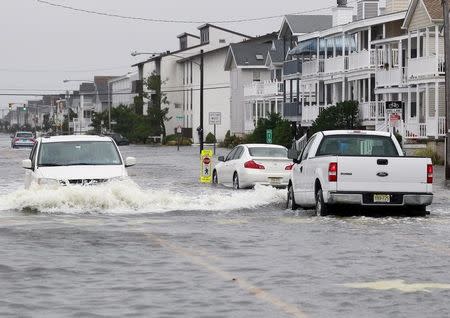Hurricane Joaquin leaves the Bahamas, U.S. braces for separate floods
By Harriet McLeod CHARLESTON, S.C. (Reuters) - Hurricane Joaquin regained strength on Saturday as it swirled away from the Bahamas with the fate of a missing cargo ship and its 33 crew still unknown, while vast swaths of the U.S. Southeast and mid-Atlantic braced for more heavy rains and flooding from a separate weather system. By 12 p.m. EDT (1600 GMT), Joaquin had strengthened significantly since Saturday morning and now had maximum sustained winds of 155 miles (250 km) per hour, the U.S. National Hurricane Center said, bringing it back up to a potentially catastrophic Category 4 on a scale of 1 to 5. The storm was about 595 miles (960 km) southwest of Bermuda, the Miami-based NHC said. But the NHC warned that any slight eastward deviation in the forecast track could put the storm dangerously to Bermuda. After battering the Bahamas for more than two days, the center of Joaquin was churning away from the island chain and was expected to pass just west of Bermuda, well off the U.S. coastline, on Sunday, the NHC said. Joaquin's top sustained winds had weakened to 125 mph (205 km) on Friday, making it a Category 3 hurricane. But it regained Category 4 status on Saturday, with hurricane force winds extending up to 70 miles (110 km) from its center. The U.S. Coast Guard said there was still no trace on Saturday of El Faro, a 735-foot (224-m) cargo ship that vanished off Crooked Island in the Bahamas on Thursday morning after it was overcome by heavy weather from Joaquin. The vessel, with 28 U.S. citizens and five Polish nationals aboard, was headed to San Juan, Puerto Rico, from Jacksonville, Florida when it reported losing propulsion and that it was listing and taking on water, the Coast Guard said. It said there had been no further communications after a distress call received at about 7:30 am (1130 GMT) Thursday. While Joaquin has continued to shift away from the U.S. East Coast, dangerous flooding triggered by heavy rainfall was expected across much of the Carolinas and parts of Georgia, Virginia and New Jersey this weekend, U.S. forecasters said. It has been raining across much of the region all week, and the accumulated rainfall, coupled with more on the way from a weather system loosely connected with Joaquin, has prompted repeated flood warnings from the National Weather Service. South Carolina emergency officials said flash flood warnings were issued for numerous counties on Saturday. They said scores of homes had already been evacuated, including in the coastal county that includes Myrtle Beach. More than 15 inches (38 cm) of rain has fallen over the popular beach area since Friday, with more expected, the National Weather Service in Wilmington, North Carolina, reported. "These kind of prolific rainfalls are not unprecedented, but this is definitely one for the history books," said NWS forecaster Dave Loewenthal in Wilmington. "We have had numerous reports of road closures. We have had roads washed out, sink holes forming," he said. "It's really a mess and we are going to have significantly more problems with multiple rivers reaching moderate flood (level) or higher." More than 100 homes have been evacuated in Brunswick County, North Carolina, and Horry County, South Carolina, due to flooding triggered by rains totaling over 15 inches, NWS meteorologist Steve Pfaff said. "It's definitely a life-threatening situation," Pfaff said. "There were people that were stuck in vehicles that were flooded and water in some of the homes was up over the electrical outlets," he added. "There is also an earthen dam in Sunset Beach (North Carolina) that is being overtopped and they are very concerned it may fail," Pfaff said. No deaths or serious injuries were reported in the Bahamas due to Joaquin, which destroyed houses, uprooted trees and unleashed heavy flooding on several smaller islands, but two deaths in the Carolinas on Thursday were linked to rain there. Before an earlier shift in Joaquin's trajectory, New York and New Jersey, where Superstorm Sandy killed more than 120 people and caused $70 billion of property damage in October 2012, both faced potential threats from the storm. (Reporting by Laila Kearney Additional reporting by Gene Cherry on Hatteras Island, N.C.; Editing by Tom Brown and James Dalgleish)




